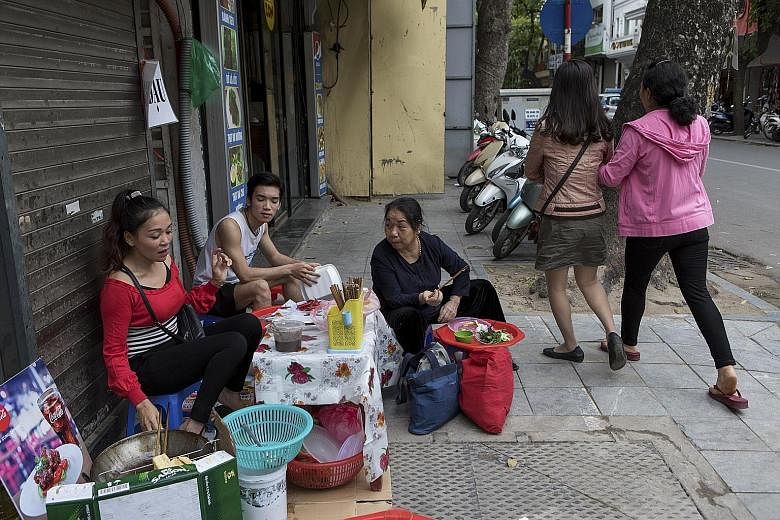HANOI • As strips of tofu sizzled beside her in a vat of oil, sidewalk vendor Nguyen Thu Hong listened for police sirens.
Police raids have escalated sharply in downtown Hanoi since March, she said.
The fine levied is about US$9 (S$12.50), or two days' earnings, for the crime of selling bun dau mam tom - vermicelli rice noodles with tofu and fermented shrimp paste - from a plastic table beside an empty storefront.
"Most Vietnamese live by what they do on the sidewalk, so you can't just take that away," she added.
"More regulations would be fine, but what the cops are doing now feels too extreme."
South-east Asia is famous for its street food, delighting tourists and locals alike with inexpensive dishes such as spicy som tam (green papaya salad) in Bangkok or sizzling banh xeo crepes in Ho Chi Minh City.
But three countries are strengthening campaigns to clear the sidewalks, driving thousands of food vendors into the shadows and threatening a culinary tradition.
Officials said the campaigns in Thailand, Vietnam and Indonesia are largely aimed at promoting public order and food safety.
In Bangkok, the military junta has been clearing vendors from spots where pedestrians have complained about littering, sidewalk congestion and vermin, officials said.
The plan is to move some hawkers into designated areas that would be more hygienic.
"Bangkok wasn't so congested" when the 1992 law regulating street vendors came into effect, said Mr Vallop Suwandee, chairman of advisers to Bangkok's governor.
"But now it is, so we have to reorganise and reorder public spaces."
According to government data, Bangkok now has fewer than 11,000 licensed vendors, about half the number it had two years ago.
In Hanoi and Ho Chi Minh City, officials have led "sidewalk reclamation" campaigns in recent months that have fuelled a nationwide debate about how to regulate street vending.
And in Jakarta, the Indonesian capital, the authorities frequently evict hawkers or keep them in limbo by forcing them to pay thousands of dollars in annual "security" and "cleaning" fees that still do not guarantee a right to work.
Since 2015, 17,000 sidewalk vendors have been moved into designated lots, city officials said, while an additional 60,000 or so still ply their trade wherever they can.
But in trying to modernise, these cities risk diluting their local flavour.
Eating street food was a way of life in South-east Asia long before the region became popular with globe-trotting foodies such as Anthony Bourdain and famous chefs started peddling classic street-food dishes in fancy Western restaurants.
Even today, as millions of South-east Asian consumers develop a taste for pizza, burgers and air-conditioned shopping malls, the region's humble sidewalk stalls still appeal to eaters of nearly all social classes. "Some vendors have been selling food around here for more than 10, 20 years, and I feel as though they have become cooks for my family," Mr Piya Joemjuttitham, a financial executive, said as he bought a mango smoothie from a sidewalk stand in downtown Bangkok.
Some street chefs have devoted followers who line up early for a dish and legions of diners contend that the best bun cha (barbecued pork with noodles) in Vietnam, like the best khao man gai (steamed chicken on rice) in Thailand, is found on city streets.
Returning to Vietnam after years abroad was "pure happiness", Hanoi-based Vietnamese-American author Nguyen Qui Duc wrote.
"But few things can compare to eating bun cha. In Hanoi. On the streets."
The fear is that these chaotic cities will end up with sanitised food scenes like that of Singapore, a financial hub that began moving its street vendors into regulated food courts and hawker centres in the 1960s.
Mr Peter Sousa Hoejskov, a food safety expert with the World Health Organisation (WHO) in Manila, said the Singapore model is among the region's best for addressing links between street vending and food-borne disease.
But the price of the shift to hawker centres, some gourmands say, is the loss of atmosphere.
And some experts say street food is not inherently less sanitary than restaurant food.
"If you're eating fried foods or things that are steaming-hot, then there's probably not much difference," said Mr Martyn Kirk, an epidemiologist at the Australian National University.
The WHO and the Food and Agriculture Organisation of the United Nations are developing a code for street vending in Asia that would establish best hygiene practices and offer broad guidelines on how governments could regulate the industry.
But, in the meantime, street vendors will have to keep looking out for police raids.
NYTIMES

